LEED Green Building Certification is an internationally developed green building rating system for all building types, from hospitals, data centers, historic buildings to schools.
What are the LEED Certification Levels?
LEED certification is awarded at four different levels:
LEED Certification: This level is awarded for buildings with basic eco-friendly features. (40-49 points)
LEED Silver Certification: This level is awarded for buildings with higher eco-friendly characteristics. (50-59 points)
LEED Gold Certification: This level is awarded for buildings with higher eco-friendly characteristics. (60-79 points)
LEED Platinum Certification: This level is awarded for buildings with the highest eco-friendliness. (80+ points)
Certification is made according to these levels, at which level is a certified building more environmentally friendly.
What are LEED Building Types?
LEED offers certification programs for many different building types. Among them:
- LEED for New Construction: For newly constructed buildings
- LEED for Core & Shell: For foundation and body
- LEED for Schools
- LEED for Retail: For stores
- LEED for Healthcare: For healthcare
- LEED for Homes: Applies to single-family homes, low-rise (one to three stories) or mid-rise buildings (four to six stories).
- LEED for Data Centers: For data centers
- LEED for Warehouses and Distribution Centers: For warehouse and distribution centers
- LEED for Hospitals
- LEED for ID+C Interior Design and Construction: For interior design and construction
- LEED BD+C (Building Design + Construction): Applies to buildings that are newly constructed or are undergoing major renovations.
- LEED O+M (Building Operations and Maintenance): Applies to existing buildings.
- LEED ND (Neighborhood Development) : Applies to residential use, non-residential uses or urban transformation projects.
These are just a few examples, the LEED program offers certification programs for different industries.
What are LEED Categories?
LEED certification programs are evaluated in certain categories. Among these categories:
Natural Environment: Conservation and sustainability of the natural environment for the building
Energy and Atmosphere: Building energy efficiency and reduction of atmospheric emissions
Water Efficiency: Water saving and efficient use
Materials and Products: Use of environmentally friendly materials and products
Human Health and Well-being: The effect of indoor environment on human health
Human Experience: Improving the user experience inside the building
Environmental Responsibility: Importance of environmental awareness and sustainability for the building
These categories determine the scores required for certification. The building can be certified by scoring certain points in the categories.
What are the important applications in Green Building Applications?
Green Building applications cover topics such as energy efficiency, water saving, use of environmentally friendly materials, indoor quality and environmental impact. Among the important applications:
Energy efficiency: Green buildings use highly efficient heating, cooling and lighting systems to save energy.
Water conservation: Green buildings use water recovery, water saving devices and water management systems to conserve water.
Use of environmentally friendly materials: Green buildings reduce environmental impact by using environmentally friendly materials.
Indoor quality: Green buildings use ventilation and filtration systems to improve indoor air quality.
Environmental impact: Green buildings use practices such as energy and water conservation, use of environmentally friendly materials, and indoor quality to reduce environmental impact.

